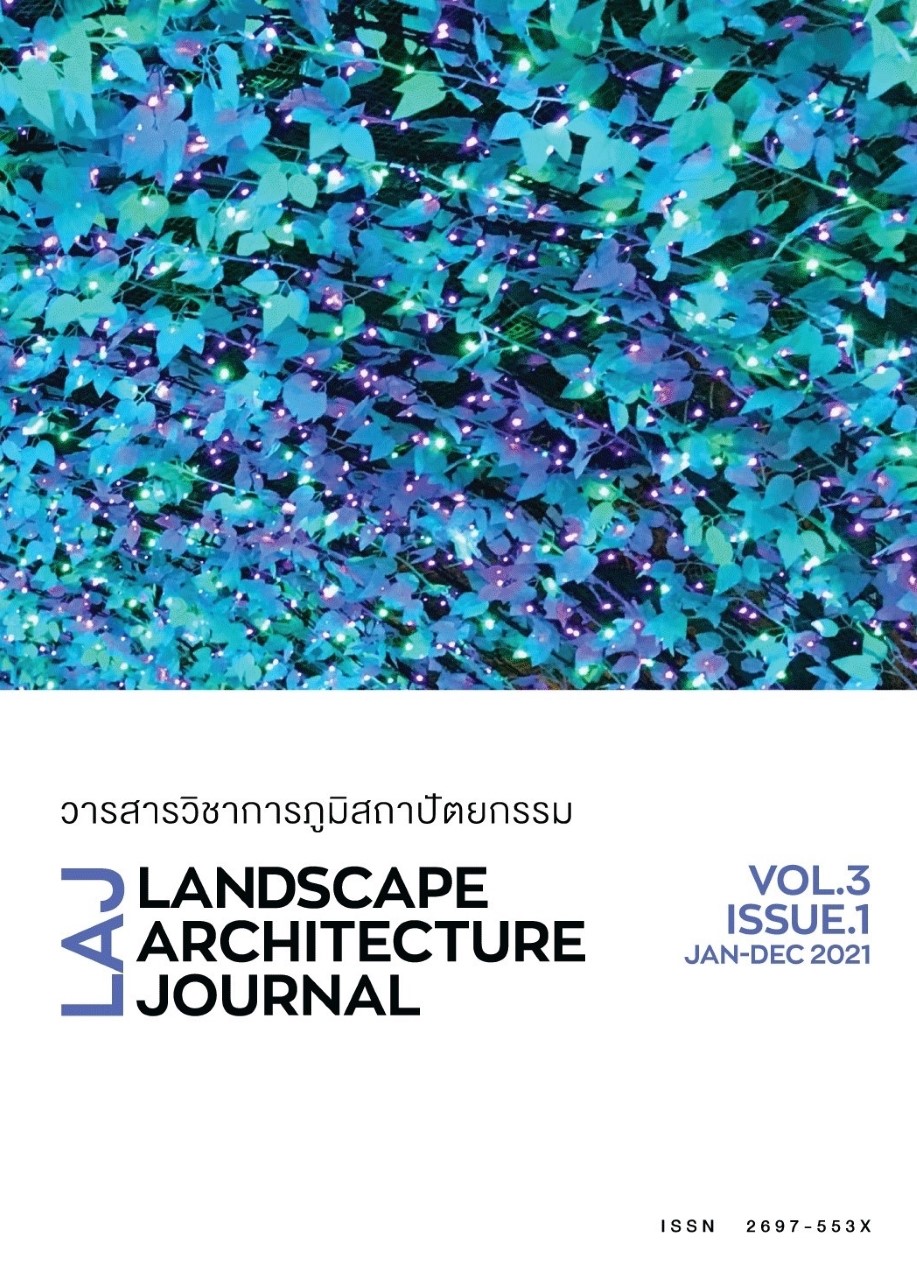Feelings and Reactions to Change of Everyday Landscape: A Case Study of Bang Aoi-Chang Community, Nonthaburi Province
Main Article Content
Abstract
Khlong-Aom-Non area is a central land for durian production of Nonthaburi province. However, due to urban encroachment, social changes, and natural disasters, the vast continuous green patch of the area has been being spoiled, particularly during the past two decade. Bang-Aoi-Chang is an old community in Khlong-Aom-Non. People in the community have been working on durian orchards for generations. However, in 2011, the community lost all of their durian trees in an unforgettable flood. Additionally, after the flood, the farmers found that new young durian tree kept dying. Both long-term and immediate landscape changes have threatened the place attachment of those people. Consequently, they have put a lot of efforts into saving their meaningful landscapes. This article presents part of results found from an ethnographic study. Working on various data gathering methods, the study aims to gain insight into thoughts, feelings, and reactions of people in Bang-Aoi-Chang when their everyday landscape has been altered. Applying on thematic analysis and adopting place identity theory as the main conceptual framework, the study reflected the values of the orchard landscape attached to personal identity of the people. As a result of the landscape changes, the feeling of uncomfortable and unsatisfied feelings emerged. Policies were criticized. Actions were applied in order to protect their landscape.
Article Details

This work is licensed under a Creative Commons Attribution-NonCommercial-NoDerivatives 4.0 International License.
References
พอพันธ์ อุยยานนท์, ศิริพร สัจจานันท์, ฐิติมา โห้ลายอง, และอภิญญา วนเศรษฐ. (2561). การคุ้มครองพื้นที่เกษตรกรรม: กรณีศึกษาพื้นที่การปลูกทุเรียน จังหวัดนนทบุรี. วารสารศรีนครินทร์วิโรฒวิจัยและพัฒนา (สาขามนุษยศาตร์และสังคมศาสตร์), 10(9), 89-101.
ธนาศรี สัมพันธารักษ์. (2546). ผลกระทบจากการพัฒนาและการขยายตัวของเมืองที่มีต่อพื้นที่เกษตรกรรมชานเมือง: กรณีศึกษาชุมชนเกษตรบางรักน้อย จังหวัดนนทบุรี. ใน การประชุมทางวิชาการของมหาวิทยาลัยเกษตรศาสตร์ ครั้งที่ 41: สาขาวิศวกรรมศาสตร์และสาขาสถาปัตยกรรมศาสตร์, กรุงเทพฯ, 597-606.
ราชกิจจานุเบกษา เล่มที่ 122 ตอนที่ 27ก, 22 มีนาคม 2548. (2548). กฎกระทรวงให้ใช้บังคับผังเมืองรวมจังหวัดนนทบุรี พ.ศ. 2548. กรุงเทพฯ: กระทรวงมหาดไทย.
สุรสังกาศ วิริยรัตนกุล. (2549). วิเคราะห์หาพื้นที่ที่มีศักยภาพและเหมาะสมในการปลูกทุเรียน จังหวัดนนทบุรี, วิทยานิพนธ์วิทยาศาสตรมหาบัณฑิต (ภูมิศาสตร์), กรุงเทพฯ: บัณฑิตวิทยาลัย มหาวิทยาลัยศรีนครินทร์วิโรฒ.
สำนักงานเศรษฐกิจการเกษตร. (2563). ข้อมูลเศรษฐกิจการเกษตร. สืบค้นจาก https://www.oae.go.th
องค์การบริหารส่วนจังหวัดนนทบุรี. (2563). ระบบตรวจสอบการใช้ประโยชน์ที่ดินตามผังเมืองรวมนนทบุรี (ปรับปรุงครั้งที่ 2). สืบค้นจาก https://urbangis.nont-pro.go.th/nontmap/
Anton, C. E. and Lawrence, C. (2014). Home is where the heart is: The effect of place of residence on place attachment and community participation. Journal of Environmental Psychology, 40, 451-461.
Antrop, M. (2005). Why landscape of the past are important for the future. Landscape and Urban Planning, 70 (1-2), 21-34.
Baldwin, C., Smith, T., and Jacobson, C. (2017). Love of the land: Social-ecological connectivity of rural landholders. Journal of Rural Studies, 51, 37-52.
Bolam, B, Murphy, S., and Gleeson, K. (2006). Place-identity and geographical inequalities in health: A qualitative study. Psychology and Health, 21(3), 399-420.
Bonaiuto, M., Breakwell, G, and Cano, I. (1996). Identity process and environmental threat: The effects of nationalism and local identity upon perception of beach pollution. Journal of Community & Applied Social Psychology, 6, 157-175.
Butler, A., Sarlov-Herlin, I., Knez, I., Angman, E., Sang, A.O., and Akerskog, A. (2018). Landscape Identity, before and after a forest fire. Landscape Research, 43(6), 878-889.
Butler, A., Knez, I., Akerskog, A., Sarlov-Herlin, I., Sang, A.O., and Angman, E. (2019). Foraging for identiy: the relationships between landscape activities and landscape identity after catastrophic landscape change. Landscape Research, 44(3), 303-319.
Carmona, M. Tiesdell, S., Heath, T., and Oc, T. (2010). Public Places-Urban Spaces. 2nd edition. Italy: Architectural Press.
Gesler, W. (1992). Therapeutic Landscape: Medical issues in light of the new cultural geography. Social Sci. Med., 34(7), 735-746.
Google Earth. (2021). Bang Aoi Chang. Retrieved from shorturl.at/hmvMU
Haslam, S. A., Jetten, J., Postmes, T., & Haslam, C. (2009a). Social identity, health and well‐being: An emerging agenda for applied psychology. Applied Psychology, 58(1), 1-23.
Haslam, S. A., Jetten, J., and Waghorn, C. (2009b). Social identification, stress and citizenship in teams: A five-phase longitudinal study. Stress and Health, 25, 21-30.
Hauge, S. A. (2006). Identity and Place. Trondheim: University of Trondheim.
Kaligaric, M. and Ivajnsic, D. (2014). Vanishing landscape of the “classic” Karst: Changed landscape identiy and projections for future. Landscape and Urban Planning, 132, 148-158.
Knez, I., Butler, A., Sang, Å. O., Ångman, E., Sarlöv-Herlin, I., & Åkerskog, A. (2018). Before and after a natural disaster: Disruption in emotion component of place-identity and wellbeing. Journal of Environmental Psychology, 55, 11-17.
Korpela, K. (1989). Place-identity as a product of environmental self-regulation. Journal of Environmental Psychology, 9, 241-256.
Loupa Ramos, I., Bernado, F., Ribeiro, S.C., and Van Eetvelde, V. (2016). Landscape identity: Implications for policy making. Land Use Policy, 53, 36-43.
Loupa Ramos, I., Bianchi, P., Bernardo, F., & Van Eetvelde, V. (2019). What matters to people? Exploring contents of landscape identity at the local scale. Landscape Research, 44(3), 320-336.
Milligan, C, Gatrell, A., and Bingley, A. (2004). Cultivating health: therapeutic landscapes and older people in northern England. Social Science & Medicine, 58, 1781-1793.
Relph, E. (1976). Place and placelessness (Vol. 67). London: Pion.
Stedman, R. C. (2003). Is it really just a social construction?: The contribution of the physical environment to sense of place. Society &Natural Resources, 16(8), 671-685.
Stobbelaar, D. J., & Pedroli, B. (2011). Perspectives on landscape identity: A conceptual challenge. Landscape Research, 36(3), 321-339.
Tajfel, H, and Turner, J.C. (1979). An integrative theory of intergroup conflict. in Austin, W.G. and Worchel, S. (eds.). The Social Psychology of Intergroup Relations. Chicago: Nelson-Hall, 33-47.
Taylor, K. (2009). Cultural landscape and Asia: Reconciling international and Southeast Asian regional values. Landscape Research, 34(1), 7-31.
Walker, A.J. and Ryan R.L. (2008). Place attachment and landscape preservation in rural New England: A main case study. Landscape and Urban Planning, 86, 141-152.
White, D., Virden, R., and van Ripe, C. (2008). Effects of place identity, place dependence, and experiences-use history on perceptions of recreation impacts in natural setting. Environmental Management, 42, 647-567.
Wiiliams, A. (2002). Changing geographies of care: employing the concept of therapeutic landscapes as a framework in examining home space. Social Science & Medicine, 55, 141-154.

